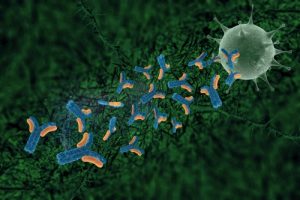“The case is important to the growing body of patents covering biologic drugs because it delineates more precisely when functionally-claimed antibody patents can survive enablement and written description challenges.”
 Patents covering an antibody are often claimed by the antibody’s function (the residues where it binds to the antigen) rather than its structure (amino-acid sequence). This tactic can successfully cast a very wide net of patent protection over potentially millions of different antibodies. In doing so, even if the patent holder’s own antibodies never make it out of the laboratory, the patents can nevertheless corner the market on intellectual property covering a new class of inhibitors.
Patents covering an antibody are often claimed by the antibody’s function (the residues where it binds to the antigen) rather than its structure (amino-acid sequence). This tactic can successfully cast a very wide net of patent protection over potentially millions of different antibodies. In doing so, even if the patent holder’s own antibodies never make it out of the laboratory, the patents can nevertheless corner the market on intellectual property covering a new class of inhibitors.
The risk of this strategy, however, is that extremely broad patent scope can simultaneously doom a patent’s validity for not being sufficiently enabled or lacking written description. As an example, a recent decision from the District of Delaware, MorphoSys AG v. Janssen Biotech, Inc., No. 16-221 (LPS) (Dkt. 471) (Jan. 25, 2019), invalidated broad antibody patents for not being sufficiently enabled, as well as coming near to invalidating the same patents for lacking written description. The case is important to the growing body of patents covering biologic drugs because it delineates more precisely when functionally-claimed antibody patents can survive enablement and written description challenges.
Enablement Analysis
MorphoSys brought suit against Janssen Biotech and Genmab alleging infringement of three U.S. patents related to sales of the drug Darzalex® (chemical name, “daratumumab”). The patents claim a CD38-inhibitor antibody for treating blood cancer, including U.S. Patent Nos. 8,263,746; 9,200,061 and 9,758,590. The ‘746 patent and ‘590 patent each cover certain types of anti-CD38 antibodies, and the ‘061 patent covers methods for treating hematologic cancer associated with the presences of CD38+ cells.
MorphoSys’ patents were drafted in a manner not uncommon for antibody patents. Rather than claiming the antibodies by their structure, such as a sequence of amino acids, the antibodies are claimed by their function. For instance, claim 14 of the ‘746 patent claims the antibody based upon where it binds on CD38. The claim recites: “An isolated human or humanized antibody or antibody fragment thereof containing an antigen-binding region which specifically binds within amino acids 44 to 206 of CD38 (SEQ ID NO: 22).”
In advance of the trial, Janssen moved for summary judgment that the asserted claims were invalid as not sufficiently enabled or lacking written description. The Court held that the claims were not sufficiently enabled. The claims, as drafted, encompassed a “very large” number of different, unique antibodies—on the order of at least millions. The specification, however, only disclosed four example embodiments that fell within the scope of the claims. The key question was whether these four embodiments enabled the “full scope” of the claim.
“Undue Experimentation”
To be enabling, the specification must teach “how to make and use the full scope of the claimed invention without undue experimentation.” (MorphoSys citing MagSil Corp. v. Hitachi Glob. Storage Techs., Inc., 687 F.3d 1377, 1380 (Fed. Cir. 2012). The Court in MorphoSys acknowledged that enabling the “full scope” of a claim does not mean the specification must identify each and every antibody covered by the claims. The Court nevertheless held that the “full scope” of a claim covering an antibody will not be enabled if there exists an embodiment encompassed within the claim’s scope that cannot be discovered without undue experimentation.
The Court found that there are at least two ways to identify new antibodies potentially covered by a patent claim: either from scratch, with techniques such as phage display or transgenic mice, or through variants of antibodies known to be effective.Variants of an antibody can be made via amino-acid substitutions within the framework regions or the complementary-determining regions (CDRs). Variants made through substitutions within the framework regions (known as “conservative” variants) are unlikely to have a large impact on the antibodies functional properties, and are therefore reasonably expected to be effective.
The same, however, cannot be said for “non-conservative” variants, such as through substitutions within the CDRs. Changes to an antibody’s CDRs can yield unpredictable impact on its binding properties. Thus, non-conservative variants would have be screened to determine efficacy.
In this case, the Court concluded that screening non-conservative variants for efficacy (such as binding properties, cell-killing activity, and so forth) would require considerable time and effort. Indeed, MorphoSys’ own witnesses admitted that the process would bear the typical hallmarks of undue experimentation—“extremely laborious,” “involving trial-and-error experimentation,” exhibiting “a lot of variability,” and requiring a “period of months.”
And therein lay the key to the Court’s reasoning: if non-conservative variants of example antibodies disclosed in the specification are nevertheless encompassed within the patent’s claim scope, yet those non-conservative variants yield no predictable efficacy without undue experimentation, then the full scope of the claim is not enabled. The Court pointed to MorphoSys’ own experience, which required multiple years to isolate, purify and characterize the four example antibodies disclosed within its own patents.
Furthermore, in this case, Janssen’s daratumumab antibody was itself a non-conservative variant of the example antibodies disclosed within MorphoSys’ patents. That distinction alone may become a presumption for judging enablement of antibody patents that are claimed based upon their binding properties: is the accused antibody a non-conservative variant of the patent’s example antibodies (requiring, for example, CDR substitutions)?
Unpredictable Art
Another key factor identified by the Court was the predictability of the art for antibody patents. Specifically, the Court found that non-conservative variants of known antibodies did not yield predictable correlations between their function and their antibody sequences. The Court stated, “[a] POSA would not be able to predict the function of these [non-conservative variant] antibodies from their sequences.” This bolstered the Court’s finding that discovering non-conservative variants would require substantial time and effort.
The implication of this reasoning could resonate to many existing antibody patents. If the state of the art is such that varying the CDRs of a known antibody carries no reasonable expectation of binding properties or other functions, then that may potentially doom an antibody patent as not sufficiently enabled. This is especially so for patent claims that have been drafted so broadly to encompass such non-conservative variants. This risk undoubtedly increases when patents claim antibodies primarily based upon their functional binding properties, as many antibody patents do.
Indeed, this same fact was also material to the Court’s analysis of the same claims for lack of written description. Multiple MorphoSys witnesses admitted that this particular antibody’s binding properties cannot be predicted from its sequence. Given the known lack of a relationship, therefore, between the antibody’s structure (sequence) and its binding properties, the Court found, “the only reasonable conclusion is that the specification does not sufficiently disclose structural features common to the members of the genus.” This finding served as the basis for the Court to grant partial summary judgment on whether the patents were invalid for lack of written description.
Implications and Next Steps
Putting aside the legal and scientific gymnastics of walking through a rigorous enablement and written description analysis for an antibody patent, the clear implication from the Delaware Court’s analysis is fairly straightforward: MorphoSys may have obtained patents covering Janssen’s and Genmab’s daratumumab protein, but MorphoSys simply did not invent that protein.
MorphoSys’ litigation against Janssen is not the only high-profile case involving protein patents that claim an antibody primarily based upon its function (binding properties) rather than its structure. The dispute between Amgen and Sanofi/Regeneron over their competing PCSK9-inhibitors involved similar patents asserted by Amgen. That case led to the Federal Circuit’s precedential decision (Amgen v. Sanofi) that effectively rejected the “newly-characterized antigen” test, and thereby, raised the bar for satisfying the written description requirement for antibody patents.
MorphoSys’ case against Janssen is scheduled to go to a bench trial in late February to address the defendants’ outstanding claim for inequitable conduct. Accordingly, the case is unlikely to be appealed to the Federal Circuit for several months. Yet, the vitality of scores of functionally-claimed antibody patents could hang in the Federal Circuit’s review of the Delaware Court’s enablement analysis in the case between MorphoSys and Janssen.
Indeed, in both Amgen’s PCSK9 case and MorphoSys’ CD38 case, the asserted patents were broad enough that the defendants eventually stipulated to infringement of many or all of the asserted claims. This underscores how much these broad-claimed antibody patents have come close to cornering the IP market for a particular inhibitor. Between the Amgen v. Sanofi case and a potential Federal Circuit decision in MorphoSys in the next year or so, cornering the IP market on a new class of inhibitor may become a lot harder.
Image Source: Deposit Photos
Image ID: 58868455
Copyright: vitstudio

![[IPWatchdog Logo]](https://ipwatchdog.com/wp-content/themes/IPWatchdog%20-%202023/assets/images/temp/logo-small@2x.png)

![[[Advertisement]]](https://ipwatchdog.com/wp-content/uploads/2024/04/Patent-Litigation-Masters-2024-banner-early-bird-ends-Apr-21-last-chance-938x313-1.jpeg)
![[Advertisement]](https://ipwatchdog.com/wp-content/uploads/2024/04/Patent-Litigation-Masters-2024-sidebar-early-bird-ends-Apr-21-last-chance-700x500-1.jpg)

![[Advertisement]](https://ipwatchdog.com/wp-content/uploads/2021/12/WEBINAR-336-x-280-px.png)
![[Advertisement]](https://ipwatchdog.com/wp-content/uploads/2021/12/2021-Patent-Practice-on-Demand-recorded-Feb-2021-336-x-280.jpg)
![[Advertisement]](https://ipwatchdog.com/wp-content/uploads/2021/12/Ad-4-The-Invent-Patent-System™.png)







Join the Discussion
2 comments so far.
mike
February 4, 2019 12:44 pm@Semion Naidis at 1 – Are you referring to Markush claims for small molecule chemical structures? I don’t believe those would be affected by this decision. The issue the Delaware court seemed to have was that the applicant was trying to claim specific forms of matter (antibody structures), but that those forms (structures) claimed could not be determined by reading the claim. You could only tell what structures were covered by the claims by actually generating the antibody and performing the functional test. A Markush claim to a chemical structure does not have this issue; even if there are millions of structures covered by the claim, there is no doubt when looking at a chemical structure whether it is in fact covered by the claim.
Semion Naidis
February 3, 2019 06:44 pmHow is that similar to markush claims? Can we tell the same about markush – that if the claims are too broad there won’t be enablement? Is this the end of markush?